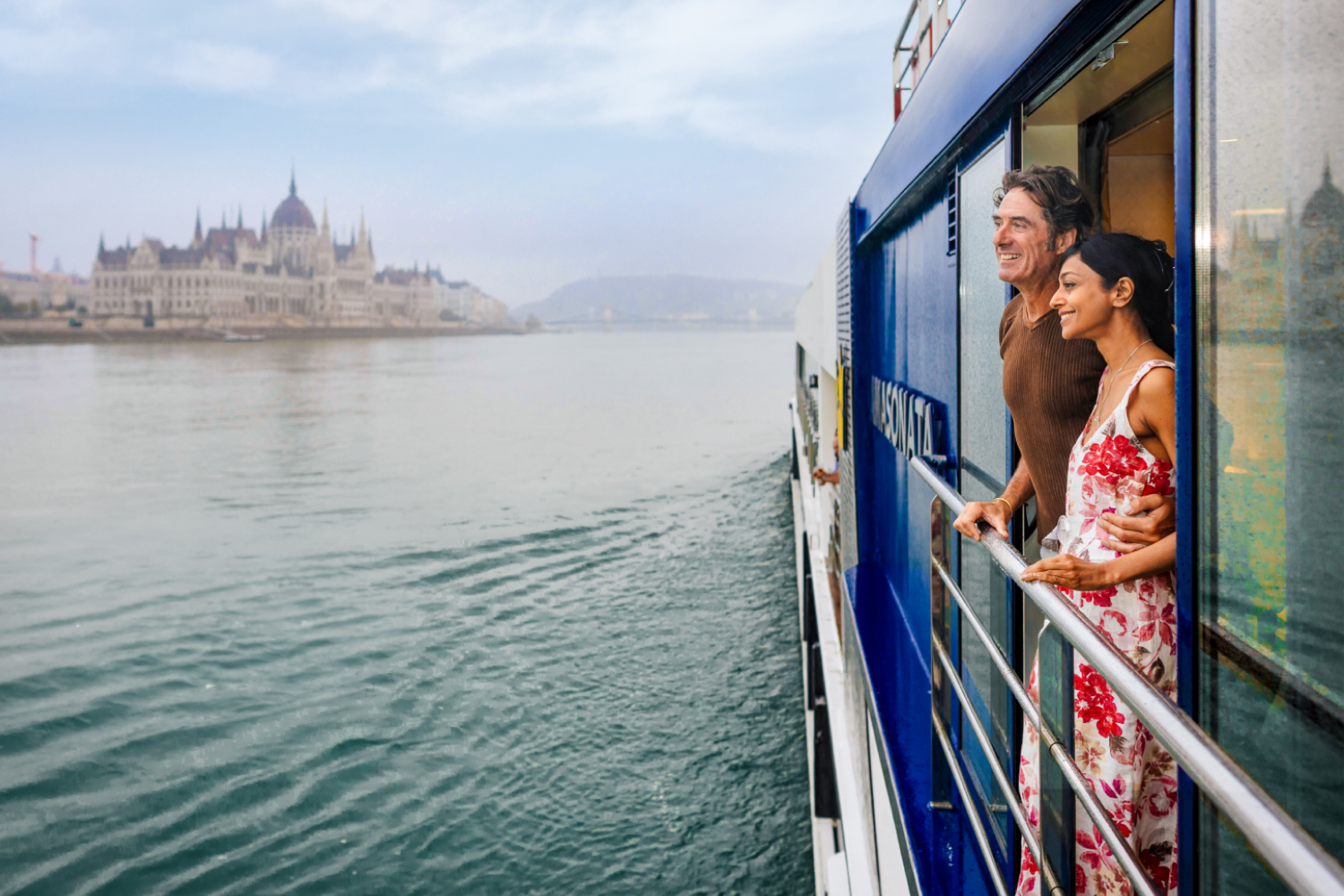Itinerary
Budapest is the capital city of Hungary and is located over the River Danube. It is one of the largest cities in the European Union and much of its historical sites have been awarded UNESCO World Heritage Site status. Originally formed in 1873 by the joining of Buda, Pest and Old Buda, the city suffered heavy destruction during World War II and was rebuilt into the country’s political, cultural and commercial hub it is now. Bridges and railways connect the city over the Danube, including the six small islands situated on the river themselves. Some of Budapest’s UNESCO World Heritage sites include Chain Bridge, Budapest Parliament, the striking Matthias church and the iconic Royal Palace visible from every location within Budapest City. The Castle Hills district architecture represents over a thousand years of the city’s history with examples of Roman, Turkish, Gothic, Renaissance and Art Nouveau styles. Budapest also has a rich Jewish heritage and is home to the largest synagogue in Europe. The city has an abundance of restaurants offering international cuisines, as well as traditional Hungarian dishes ,including goulash soup, a very popular lunchtime dish. Hungarians enjoy their coffee so a traditional cafe is never hard to find.
Day programme:
ARRIVE IN BUDAPEST, HUNGARY – EMBARKATION. Board the ship in Budapest for your Magnificent Europe cruise. (D)
Bratislava is the capital city of Slovakia and is located along the Danube a river on the borders of Austria and Hungary. The city is surrounded by the Little Carpathians Mountains and vineyards as well as its iconic reconstructed Bratislava Castle overlooking Old Town. The castle offers a picturesque view of the city, the neighbouring countries and is home to the Museum of History. Bratislava offers a blend of historic and modern attractions including the Old Town Hall, now home to the Bratislava City Museum, the UFO Bridge, Martin’s Cathedral, Michael’s Gate and Blue Church St Elizabeth’s. Bratislava is home to one of the oldest city parks in Central Europe and is popular with walkers, runners and cyclists as is the city forest park and foothills of the Carpathian Mountains. The city is popular for its locally brewed beers and has many micro-breweries and underground beer cellars. The local cuisine of Bratislava is an eclectic influence of European cultures including Slovak, Hungarian, Austrian and German and serves as a reminder of the history of this cosmopolitan city. However, visitors will find an array of offerings to suit all tastes with lunch being the main meal of the day and roast goose with lokse considered a signature dish of the area.
Day programme:
BRATISLAVA, SLOVAKIA. Sail to the “Coronation City of Kings,” where you can join a walking tour or choose instead to enjoy a “Tastes of Slovakia” tour. For those who wish a more active exploration, hike up to Bratislava Castle for magnificent views of the city. (B,L,D)
Vienna is the capital and largest city of Austria. Located on the Danube River in the East of the country, the city is renowned for its strong music heritage and rich culture, and is the largest German speaking city in the world, outside of Berlin. In 2001, Vienna was designated a UNESCO World Heritage Site and boasts magnificent architecture. The city is home to over 27 castles and 150 palaces including the symbolic Gothic St Stephen’s Cathedral and the iconic Schönbrunn Palace. Art and music are in abundance and all tastes are catered for. Live music venues offer everything from Rock to Opera. Enjoy world class performances at Vienna State Opera and experience the epicentre of international concert life at Musikverein. Modern and historical art can be found in indoor and outdoor spaces around the city, and a visit to the famous Kunsthistorisches Museum (KHM) is highly recommended. Enjoy views of the city from the Danube Tower and the Giant Ferris Wheel, then relax in the ample cosy coffee houses, cafes, bars and restaurants where traditional and international cuisines are served, as well as the locally produced wines.
Day programme:
VIENNA, AUSTRIA. The heart of the Austro-Hungarian Empire, Vienna, remains as renowned today as it has throughout history. The entire city center is a UNESCO World Heritage Site awash with Baroque treasures. Your city tour showcases its regal splendors, including the majestic Opera House and the former Imperial Palace of the Habsburgs. Conclude in Vienna’s historic city center and then visit the majestic St. Stephen’s Cathedral, which has stood watch over Vienna for 700 years and is one of the most important and beloved landmarks in Austria. Alternatively, enjoy a guided bike tour through Vienna. (B,L,D)
Dürnstein is a town located in the Northeast of Austria, situated on the Danube river. It is part of the UNESCO World Heritage site and wine region of Wachauer. It is a popular destination for wine lovers as many wineries offer accommodation. In addition to wine tasting and vineyard tours, visitors will find exploring the area on foot is easy and enjoyable. Take one of the many beautiful hiking trails across ancient rocks and admire the impressive views across the Danube valley. Children will enjoy exploring the outdoors of Dürnstein too, with outdoor playgrounds and theme trails available to keep them entertained. In addition, children and adults will enjoy Austria’s only outdoor biological swimming pool, Kuenringerbad, with an average temperature of 23 degrees celsius. Enjoy views of the town from overhead helicopter tours, leisurely river excursions, or hike up into the mountains and explore some of Dürnstein’s ruins. The mountains offer the ruins of Dürnstein castle and city wall as well as beautiful flora and fauna to spot.
Day programme:
DÜRNSTEIN – MELK, AUSTRIA. Once in Dürnstein, you have a choice of excursions. Partake in a walking tour along cobblestone streets to the beautiful blue Baroque Stiftskirche before enjoying a local wine tasting. For a more active adventure, hike up to the fortress where Richard the Lionheart was once held and enjoy sweeping views of the river and vineyards below. You may also choose to visit a local apricot grower, where you’ll be treated to the finest apricot products in the region. You can also join a guided bike tour along the Danube, and if you would like, you can bike later in the day further along the Danube through the UNESCO-designated Wachau Valley and meet your ship in Melk. Or, cruise to Melk, known for its magnificent Benedictine Abbey, a UNESCO World Heritage Site, which you will visit later in the day. (B,L,D)
Melk is an Austrian town situated on the River Danube. Located west of Vienna, the town is mostly famous for its 11th Century Melk Abbey, a magnificent monastery built high above the town. Melk Abbey is the largest example of Baroque architecture in the Wachau Valley, with the valley itself awarded UNESCO World Heritage Site status in 2000. Its steep terraced vineyards mean vinters cultivate with traditional manual practices and the springtime sees this unique landscape covered in apricot tree blossoms. Strolling around the streets of Melk Old Town, visitors will find the Town Hall Square, the Main Square, the old Post Office, now a local museum, Old Abbey Tavern, and Kremser Strasse. River cruises, self-guided walking tours and cycle tours are also extremely popular around Melk, as the Wachau Valley offers unique landscape to be explored and enjoyed. Art festivals and Baroque music is celebrated each year with the Melk Baroque Days, an international festival.
Linz is a city in northern Austria located on both banks of the Danube River and is a short distance from Salzburg and Vienna. Linz has been awarded UNESCO City of Media Arts status and prides itself on offering a broad spectrum of events, activities and cultural institutions. Enjoy popular open air concert such as Klassik am Dom and extravagant street performances, which attract large crowds and popular international artists. Art galleries and centres are in abundance around the city as well as many museums housing international collections and depictions of the history and heritage of Linz. The architecture of the city also plays an important role in Linz’s cultural heritage with Main Square, Old Town and Mariendom Cathedral being some key attractions. Families will enjoy a trip to Postlingberg, located high up in the mountains and featuring a zoo, the Grottenbahn and spectacular views of the river and city below.
Day programme:
ENGELHARTSZELL, GERMANY – PASSAU, GERMANY. Discover Passau in one of three ways. Enjoy a walking tour and marvel at Gothic and Italian Baroque architecture and St. Stephen’s Cathedral. Guests looking for a more active morning can choose between a guided bike tour along the Danube, or a guided hike up to the Veste Oberhaus Fortress. For those who love The Sound of Music, you can also choose to enjoy a full-day excursion to Salzburg and tour the historic center, Mirabell Gardens, Residenz Square and the Old Market. En route to Salzburg, stop at Mondsee, home of the Basilica St. Michael, where the famous wedding scene in the movie was filmed. (B,L,D)
Regensburg is a medieval city of Bavaria in southeast Germany. It is situated on the northern point of the Danube River at its confluence with the Regen and Naab rivers. The city is famous for its iconic 12th Century stone bridge and sixteen arches, crossing the Danube into Old Town and is the oldest preserved bridge in Germany. Regensburg is also noted for its 13th Century Regensburg Cathedral and Gothic twin spires that feature prominently on the city’s skyline. Recently awarded UNESCO World Heritage status, the city is home to many preserved sites. Visit the the 2nd Century Porta Praetoria which served as the north gate to a Roman camp and St Peter’s Cathedral, with its French Gothic architecture. Also the 18th Century Thurn and Taxis Palace and the Old Town Hall, which is now home to the Imperial Diet Museum, are also worth a visit. Regensburg benefits from lots of parks and gardens for visitors to relax in, as well as walks and cycle paths along the banks of the rivers.
Day programme:
REGENSBURG, GERMANY. Explore one of Germany’s best preserved medieval cities, Regensburg, on a guided walking tour showcasing the city’s architectural highlights, including the Old Town Hall and the Porta Praetoria. As an alternate option, sample some of Bavaria’s specialties—beer, sausage and pretzels. And for a more active adventure, bike to Walhalla where you will see the neoclassical white marble temple. (B,L,D)
Nuremberg is a medieval city located in northern Bavaria in Germany. It is Bavaria’s second largest city and is noted for its iconic red roofed buildings and medieval architecture. The imperial Castle overlooks Nuremberg and was one of the most important fortifications of the Roman Empire. For more significant cultural history, the Germanisches Nationalmuseum, one of the largest cultural history museums in the German speaking world, offers visitors exhibitions from Prehistoric all the way to present day. Walking tours around the city offer an enjoyable and active way to learn of Nuremberg’s history and culture. Through Old Town, discover fountains, wells, churches, and art treasures, as well as learning of the colourful past and cosmopolitan present of the city and its people. Nuremberg is also home to one of the oldest Christmas markets in Germany, the Nuremberg Christkindlesmarkt, where visitors can purchase traditional handmade decorations and enjoy the famous gingerbread, mulled wine, and grilled sausage from over one hundred and eighty wooden stalls.
Day programme:
NUREMBERG, GERMANY. You have three choices of excursions while in Nuremberg. Enjoy a guided tour through this well-preserved medieval city, showcasing the Imperial Castle, famous town wall and the legendary fountain of the Market Square. Or turn back the pages of a darker history with a guided tour of the city’s most important WWII sites, including the coliseum. You’ll also visit the Nuremberg Trials Memoriam and Courtroom 600, if the courtroom is not in session. Alternatively, partake in a traditional Franconian specialties tasting of famous Nuremburger bratwurst, rotbier (red beer) and lebkuchen (gingerbread). (B,L,D)
Nuremberg is a medieval city located in northern Bavaria in Germany. It is Bavaria’s second largest city and is noted for its iconic red roofed buildings and medieval architecture. The imperial Castle overlooks Nuremberg and was one of the most important fortifications of the Roman Empire. For more significant cultural history, the Germanisches Nationalmuseum, one of the largest cultural history museums in the German speaking world, offers visitors exhibitions from Prehistoric all the way to present day. Walking tours around the city offer an enjoyable and active way to learn of Nuremberg’s history and culture. Through Old Town, discover fountains, wells, churches, and art treasures, as well as learning of the colourful past and cosmopolitan present of the city and its people. Nuremberg is also home to one of the oldest Christmas markets in Germany, the Nuremberg Christkindlesmarkt, where visitors can purchase traditional handmade decorations and enjoy the famous gingerbread, mulled wine, and grilled sausage from over one hundred and eighty wooden stalls.
Day programme:
NUREMBERG, GERMANY. Depart the ship for a guided tour of Kaiserburg, Nuremberg’s Imperial castle and one of the most important palaces of the Old Holy Roman Empire. While wandering through this historical fortress towering high above the city center, you will pass by an exhibition of military artifacts, from weapons to suits of armor, as well as architectural models that show the castle through the ages. Following your Kaiseburg tour, we will head to the former home of Albrecht Dürer, arguably Germany’s most famous artist and Nuremberg’s most famous resident. It is within these walls where he lived and worked for nearly 20 years in the early 16th century, and you will be able to view some of his and other artists’ works during your tour. (B,L,D)
Bamberg is a German town located over a landscape of seven hills and the confluence of Regnitz and Main rivers. The town is a UNESCO World Heritage Centre with Old Town home to structures dating back to the 11th century. An iconic landmark to visit in Bamberg is the town hall Altes Rathaus, located on an island in the Regnitz and covered in murals. Bamberg Cathedral, with its four towers and numerous stone carvings, is a striking example of Romanesque architecture. Head to the Market Gardeners District and visit the historical houses where centuries ago the town gardeners would grow and export produce such as onions, seeds and liquorice. In the town centre and heart of Little Venice, the rivers and arched bridges connecting the island city are reminiscent of Venice, with a lively atmosphere and modern shops set in historical surroundings. After a day shopping, head to one of the many Brewery pubs for some popular German beer. Bamberg is famous for its beer and is where its name originated from, with the town being populated by nine traditional breweries.
Day programme:
BAMBERG, GERMANY. Explore enchanting Bamberg, a UNESCO World Heritage Site, in one of three ways. Join a guided walking tour of this medieval gem to see its cathedral, Old Town Hall and elegant old mansions. Or taste your way through the city sampling smoked beer, pralines, and Hornla, a pastry. And for a more active adventure, join a guided bike tour. (B,L,D)
Würzburg is a city in Bavaria in southern Germany. It is located on the River Main and is famous for its lavish baroque architecture and Franconian wine. The Residence Palace is a UNESCO World Heritage Site and is highly recommended. It is a well known example of Baroque architecture with its acclaimed staircase, impressive frescos and imperial hall. Other impressive sites in Würzburg include the towering fortress of Festung Marienberg, the Alt Mainbrücke old bridge, which offers ideal views of the Marienberg, Dom St. Kilian cathedral and the many churches of Würzburg including the Romanesque Neumünster. Many of these sites have their own museums for visitors to learn of the history or view unique collections. Other museums of interest are the Mineralogical Museum, exhibiting the world of minerals and stones, and the Botanical Gardens, with various greenhouses and outdoor areas to enjoy. Wine lovers will find an abundance of wineries in Würzburg, offering cellar tours and wine tasting as well as traditional Bavarian cuisines and hospitality. Enjoy wine soup, Gerupfter (cheese spread) and Sauerbraten (braised beef in wine) in a friendly traditional wine tavern.
Day programme:
WÜRZBURG, GERMANY. You have several choices of excursions. Enjoy a city tour of Würzburg, bursting with Baroque splendor. Or visit Würzburg’s Baroque Residenz Palace, a UNESCO World Heritage Site that features an opulent interior, including a grand fresco by Tiepolo. Or stretch your legs while hiking to Würzburg Castle. Alternatively, go to Rothenburg, the best-preserved medieval town in Germany. The town is so pretty that the imagery of Walt Disney’s Pinocchio was very much influenced by sketches of Rothenburg. (B,L,D)*Not combinable with other tours on this day.
Day programme:
WERTHEIM – MILTENBERG. Wertheim is considered to have one of Germany’s most beautiful city centers. While here, join a walking tour or hike to the ruins of Wertheim Castle. Later in the day, enjoy a scenic cruise to Miltenberg, the “Pearl of the Main River.” While on your walking tour, you’ll discover why this medieval town seems to leap from the pages of a fairytale with its 14th- and 15th-century half-timbered, gabled houses; the famed Crooked House; and the venerable Royal Inn. For those who would like a more active adventure, hike to the Miltenberg Castle, offering majestic views of the town and river. (B,L,D)
Rudesheim am Rhine is a town in the Rhine Valley in Germany and part of the UNESCO World Heritage Site of Rhine Gorge. It is known for its production of Riesling wine and has been popular for its wine making since ancient times. The Medieval Bromserburg Castle is home to the Rheingau Wine Museum and wine is a crucial part of Rudesheimer culture. The town is surrounded with vineyards and wineries, as well as many local wine bars and seasonal wine taverns. Wine tasting is a must do in Rudesheim and dining out is a great accompaniment. The local cuisine is seasonal and is closely intertwined with the wine growing traditions together with soups such as Zwiebelkuchen, Handkäs mit Musik and Spundekäs. Nordic Walking is popular around town, with five adventure trails around the vicinity, as well as many popular cycling routes. Great views of the town can be found from the water, the cable car to Niederwald Monument and the Monument itself. Old Town has the best examples of the town’s architecture with Eagle Tower, Oberstrasse and Rheinstein Castle some key sites to visit.
Day programme:
RÜDESHEIM, GERMANY – RHINE GORGE, GERMANY – LAHNSTEIN, GERMANY. Wine connoisseurs will want to go on a walking tour through the vineyards where you’ll stop to sample wines at three different tasting stations. Or choose to drink up the stunning views by soaring high above the vineyards with a gondola ride to the Niederwalddenkmal Statue. For a more active adventure, join a guided bike tour along the scenic Rhine River or hike through the town’s vineyards. Later in the day, let Siegfried’s Mechanical Musical Instrument Museum charm you, or taste one of the town’s special delights, Rüdesheimer coffee. (B,L,D
Amsterdam combines the unrivaled beauty of the 17th-century Golden Age city center with plenty of museums and art of the highest order, not to mention a remarkably laid-back atmosphere. It all comes together to make this one of the world’s most appealing and offbeat metropolises in the world. Built on a latticework of concentric canals like an aquatic rainbow, Amsterdam is known as the City of Canals—but it’s no Venice, content to live on moonlight serenades and former glory. Quite the contrary: on nearly every street here you’ll find old and new side by side—quiet corners where time seems to be holding its breath next to streets like neon-lit Kalverstraat, and Red Light ladies strutting by the city’s oldest church. Indeed, Amsterdam has as many lovely facets as a 40-carat diamond polished by one of the city’s gem cutters. It’s certainly a metropolis, but a rather small and very accessible one. Locals tend to refer to it as a big village, albeit one that happens to pack the cultural wallop of a major world destination. There are scores of concerts every day, numerous museums, summertime festivals, and, of course, a legendary year-round party scene. It’s pretty much impossible to resist Amsterdam’s charms. With 7,000 registered monuments, most of which began as the residences and warehouses of humble merchants, set on 160 man-made canals, and traversed by 1,500 or so bridges, Amsterdam has the largest historical inner city in Europe. Its famous circle of waterways, the grachtengordel, was a 17th-century urban expansion plan for the rich and is a lasting testament to the city’s Golden Age. This town is endearing because of its kinder, gentler nature—but a reputation for championing sex, drugs, and rock ’n’ roll does not alone account for Amsterdam’s being one of the most popular destinations in Europe: consider that within a single square mile the city harbors some of the greatest achievements in Western art, from Rembrandt to Van Gogh. Not to mention that this is one of Europe’s great walking cities, with so many of its treasures in the untouted details: tiny alleyways barely visible on the map, hidden garden courtyards, shop windows, floating houseboats, hidden hofjes(courtyards with almshouses), sudden vistas of church spires, and gabled roofs that look like so many unframed paintings. And don’t forget that the joy lies in details: elaborate gables and witty gable stones denoting the trade of a previous owner. Keep in mind that those XXX symbols you see all over town are not a mark of the city’s triple-X reputation. They’re part of Amsterdam’s official coat of arms—three St. Andrew’s crosses, believed to represent the three dangers that have traditionally plagued the city: flood, fire, and pestilence. The coat’s motto (“Valiant, determined, compassionate”) was introduced in 1947 by Queen Wilhelmina in remembrance of the 1941 February Strike in Amsterdam—the first time in Europe that non-Jewish people protested against the persecution of Jews by the Nazi regime.
Day programme:
AMSTERDAM, THE NETHERLANDS. There are 165 canals in Amsterdam, and you’ll get to enjoy some of them on your canal cruise. (B,L,D)
Amsterdam combines the unrivaled beauty of the 17th-century Golden Age city center with plenty of museums and art of the highest order, not to mention a remarkably laid-back atmosphere. It all comes together to make this one of the world’s most appealing and offbeat metropolises in the world. Built on a latticework of concentric canals like an aquatic rainbow, Amsterdam is known as the City of Canals—but it’s no Venice, content to live on moonlight serenades and former glory. Quite the contrary: on nearly every street here you’ll find old and new side by side—quiet corners where time seems to be holding its breath next to streets like neon-lit Kalverstraat, and Red Light ladies strutting by the city’s oldest church. Indeed, Amsterdam has as many lovely facets as a 40-carat diamond polished by one of the city’s gem cutters. It’s certainly a metropolis, but a rather small and very accessible one. Locals tend to refer to it as a big village, albeit one that happens to pack the cultural wallop of a major world destination. There are scores of concerts every day, numerous museums, summertime festivals, and, of course, a legendary year-round party scene. It’s pretty much impossible to resist Amsterdam’s charms. With 7,000 registered monuments, most of which began as the residences and warehouses of humble merchants, set on 160 man-made canals, and traversed by 1,500 or so bridges, Amsterdam has the largest historical inner city in Europe. Its famous circle of waterways, the grachtengordel, was a 17th-century urban expansion plan for the rich and is a lasting testament to the city’s Golden Age. This town is endearing because of its kinder, gentler nature—but a reputation for championing sex, drugs, and rock ’n’ roll does not alone account for Amsterdam’s being one of the most popular destinations in Europe: consider that within a single square mile the city harbors some of the greatest achievements in Western art, from Rembrandt to Van Gogh. Not to mention that this is one of Europe’s great walking cities, with so many of its treasures in the untouted details: tiny alleyways barely visible on the map, hidden garden courtyards, shop windows, floating houseboats, hidden hofjes(courtyards with almshouses), sudden vistas of church spires, and gabled roofs that look like so many unframed paintings. And don’t forget that the joy lies in details: elaborate gables and witty gable stones denoting the trade of a previous owner. Keep in mind that those XXX symbols you see all over town are not a mark of the city’s triple-X reputation. They’re part of Amsterdam’s official coat of arms—three St. Andrew’s crosses, believed to represent the three dangers that have traditionally plagued the city: flood, fire, and pestilence. The coat’s motto (“Valiant, determined, compassionate”) was introduced in 1947 by Queen Wilhelmina in remembrance of the 1941 February Strike in Amsterdam—the first time in Europe that non-Jewish people protested against the persecution of Jews by the Nazi regime.
Day programme:
AMSTERDAM. Disembark the ship and you prepare for your flight home. (B)
Ship features
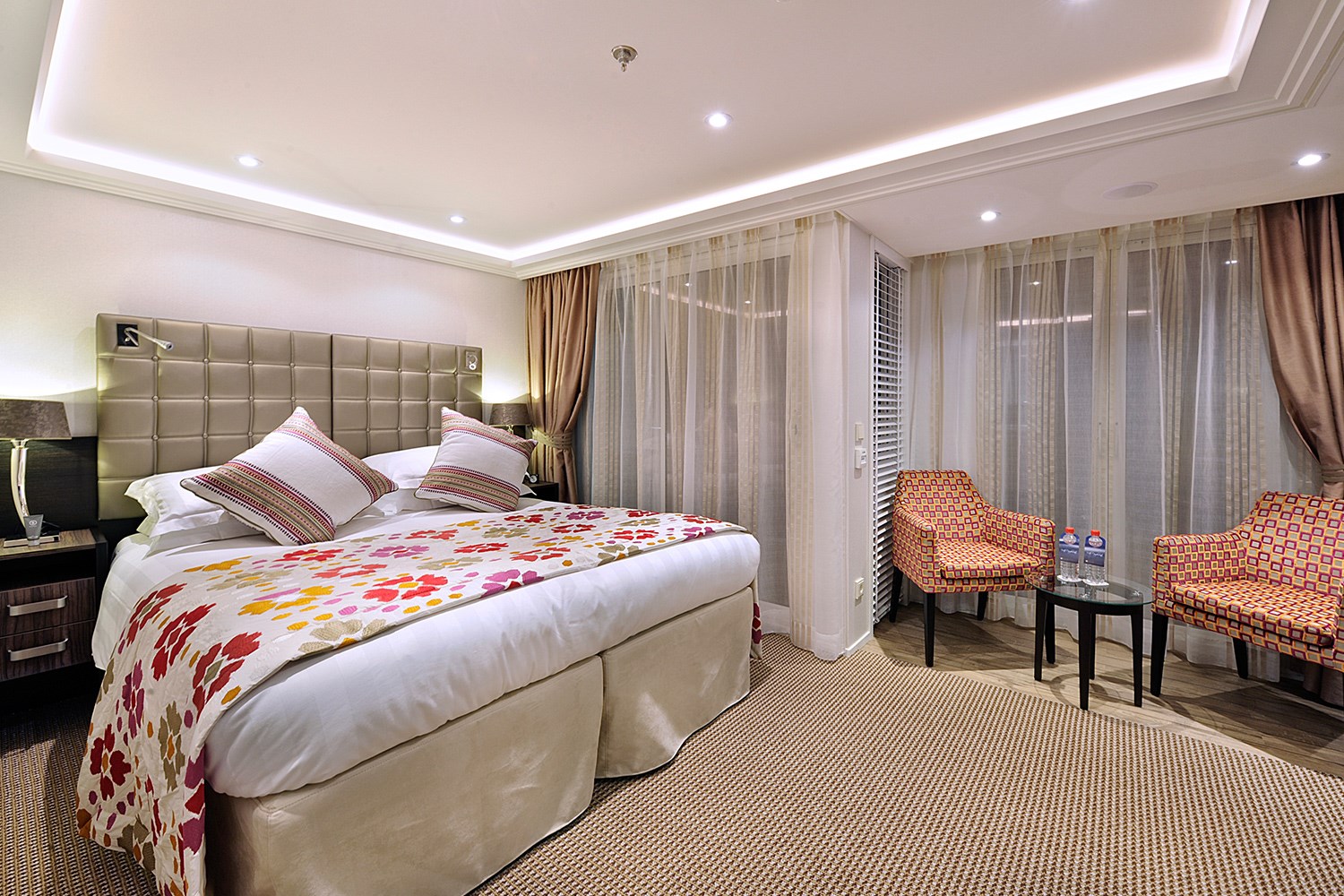
Suite
Stateroom Features
- In-room temperature control
- Spacious bathrooms with multi-jet showerheads
- Large wardrobe, full-length mirror, hair dryer, safe and direct-dial telephone
- Flat-screen TV
- Entertainment on Demand system providing complimentary TV, movies and music library
- Complimentary bottled water replenished daily
- Complimentary internet and Wi-Fi
- Desk and chair

Category AA Stateroom
Stateroom Features
- In-room temperature control
- Spacious bathrooms with multi-jet showerheads
- Large wardrobe, full-length mirror, hair dryer, safe and direct-dial telephone
- Flat-screen TV
- Entertainment on Demand system providing complimentary TV, movies and music library
- Complimentary bottled water replenished daily
- Complimentary internet and Wi-Fi
- Desk and chair
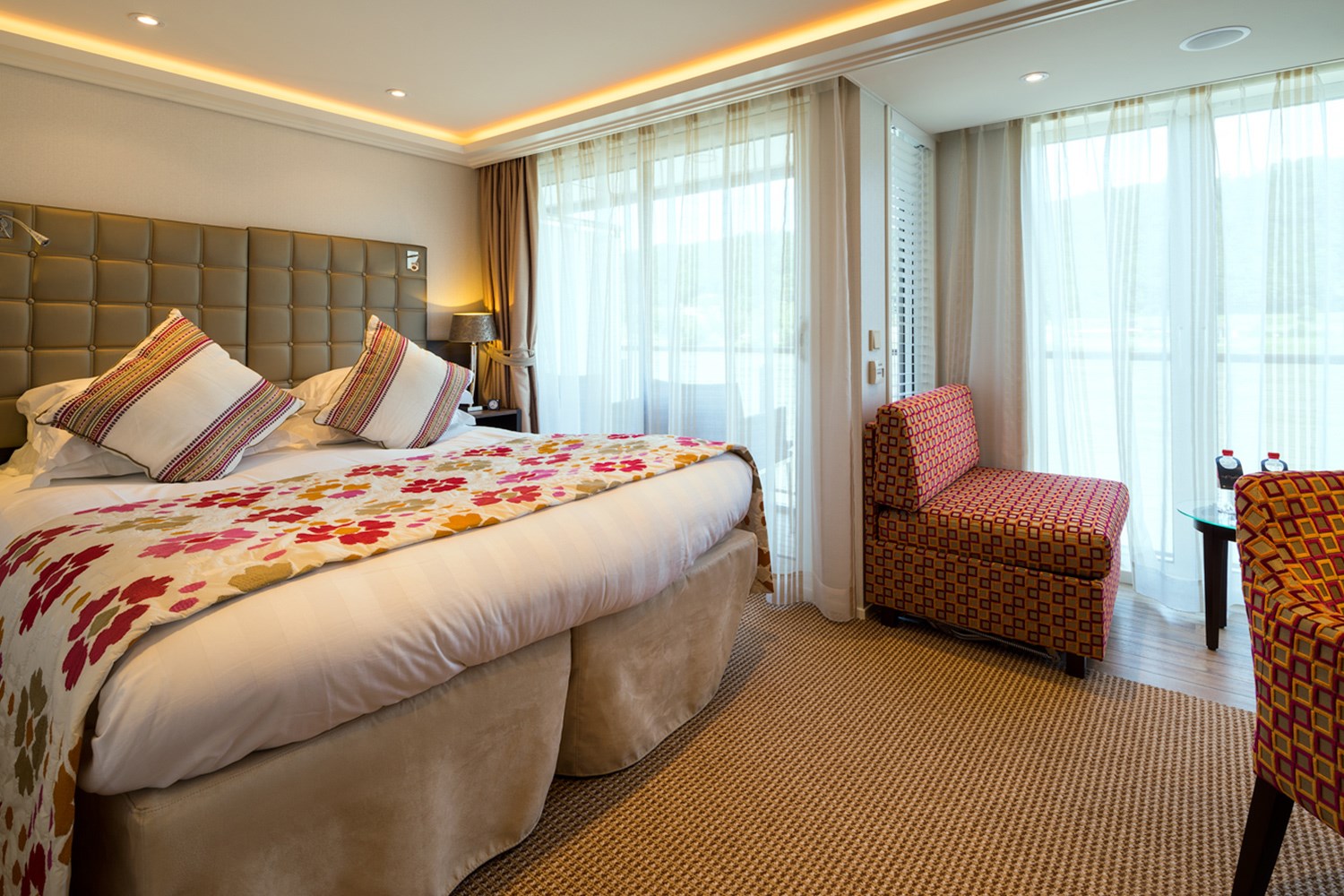
Category AB Stateroom
Stateroom Features
- In-room temperature control
- Spacious bathrooms with multi-jet showerheads
- Large wardrobe, full-length mirror, hair dryer, safe and direct-dial telephone
- Flat-screen TV
- Entertainment on Demand system providing complimentary TV, movies and music library
- Complimentary bottled water replenished daily
- Complimentary internet and Wi-Fi
- Desk and chair
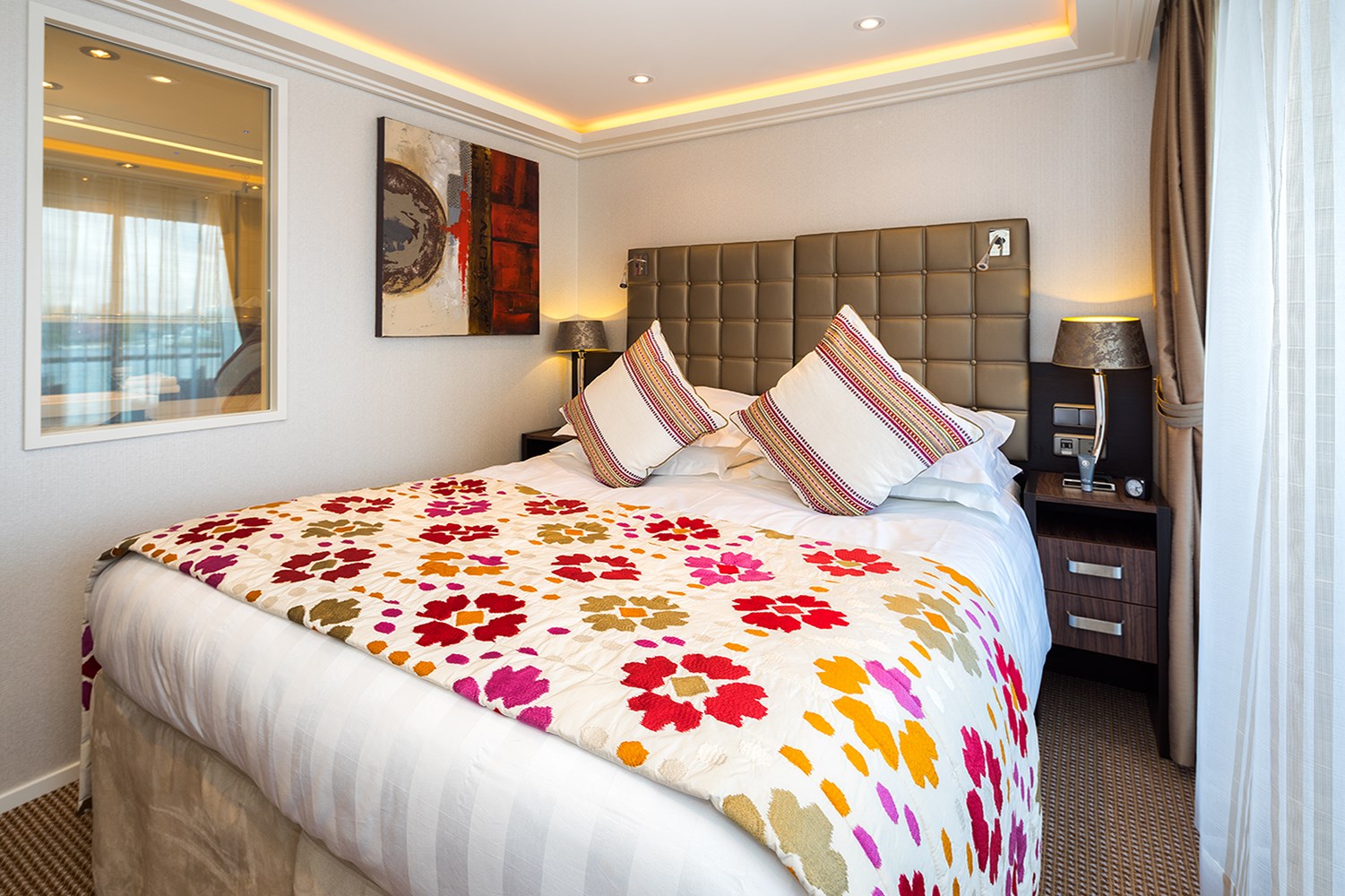
Category BA Stateroom
Stateroom Features
- In-room temperature control
- Spacious bathrooms with multi-jet showerheads
- Large wardrobe, full-length mirror, hair dryer, safe and direct-dial telephone
- Flat-screen TV
- Entertainment on Demand system providing complimentary TV, movies and music library
- Complimentary bottled water replenished daily
- Complimentary internet and Wi-Fi
- Desk and chair
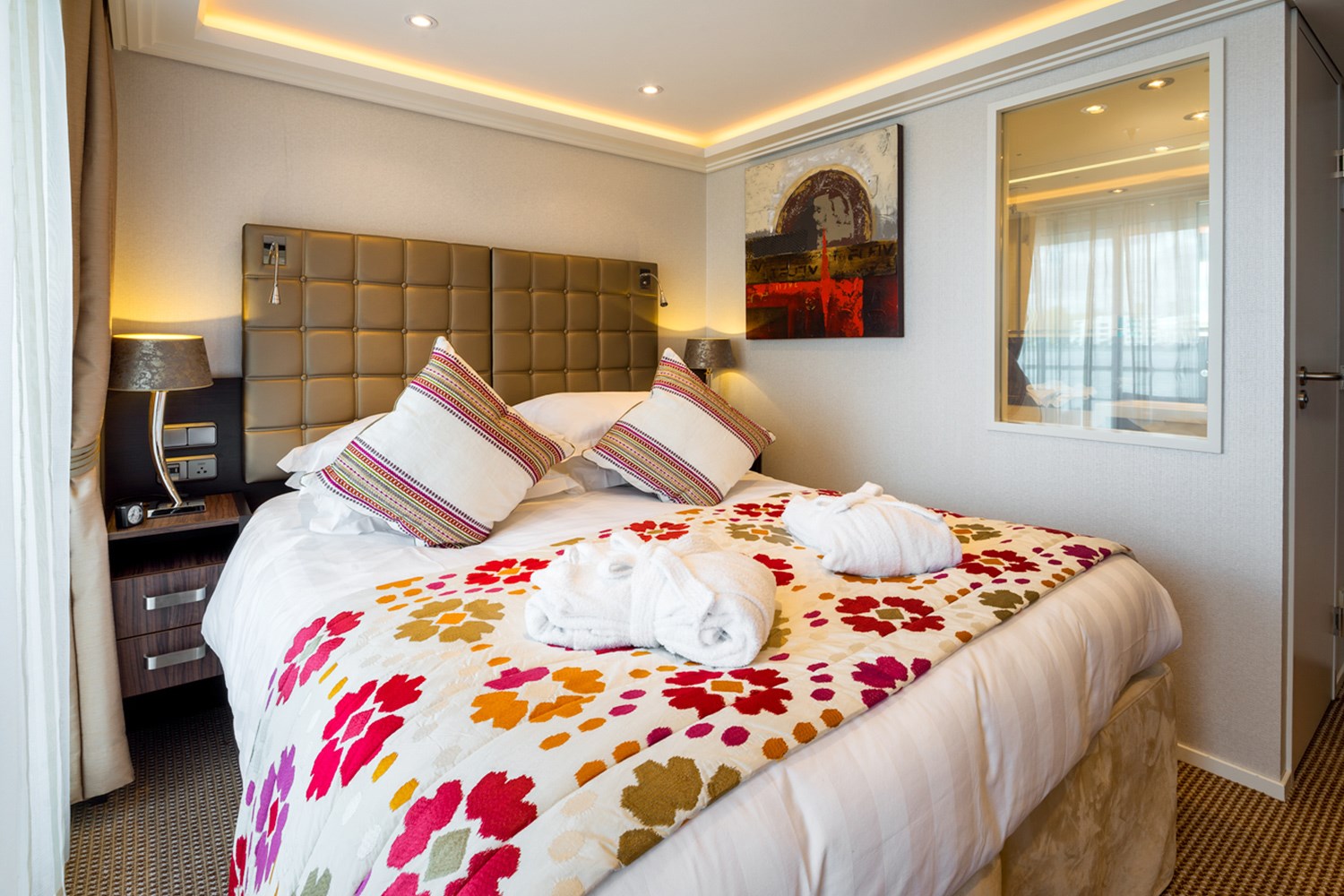
Category BB Stateroom
Stateroom Features
- In-room temperature control
- Spacious bathrooms with multi-jet showerheads
- Large wardrobe, full-length mirror, hair dryer, safe and direct-dial telephone
- Flat-screen TV
- Entertainment on Demand system providing complimentary TV, movies and music library
- Complimentary bottled water replenished daily
- Complimentary internet and Wi-Fi
- Desk and chair
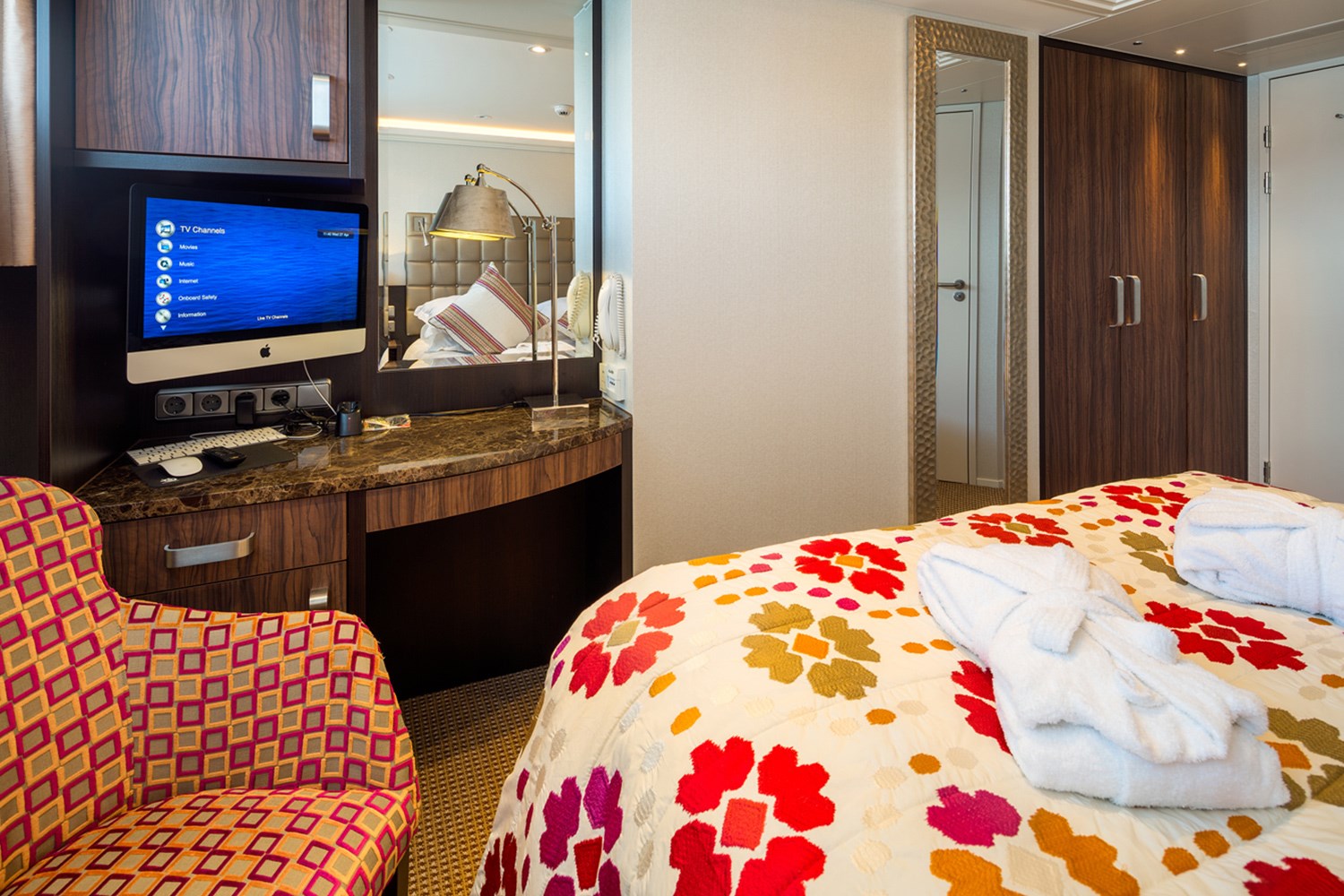
Category CA Stateroom
Stateroom Features
- In-room temperature control
- Spacious bathrooms with multi-jet showerheads
- Large wardrobe, full-length mirror, hair dryer, safe and direct-dial telephone
- Flat-screen TV
- Entertainment on Demand system providing complimentary TV, movies and music library
- Complimentary bottled water replenished daily
- Complimentary internet and Wi-Fi
- Desk and chair

Category CB Stateroom
Stateroom Features
- In-room temperature control
- Spacious bathrooms with multi-jet showerheads
- Large wardrobe, full-length mirror, hair dryer, safe and direct-dial telephone
- Flat-screen TV
- Entertainment on Demand system providing complimentary TV, movies and music library
- Complimentary bottled water replenished daily
- Complimentary internet and Wi-Fi
- Desk and chair
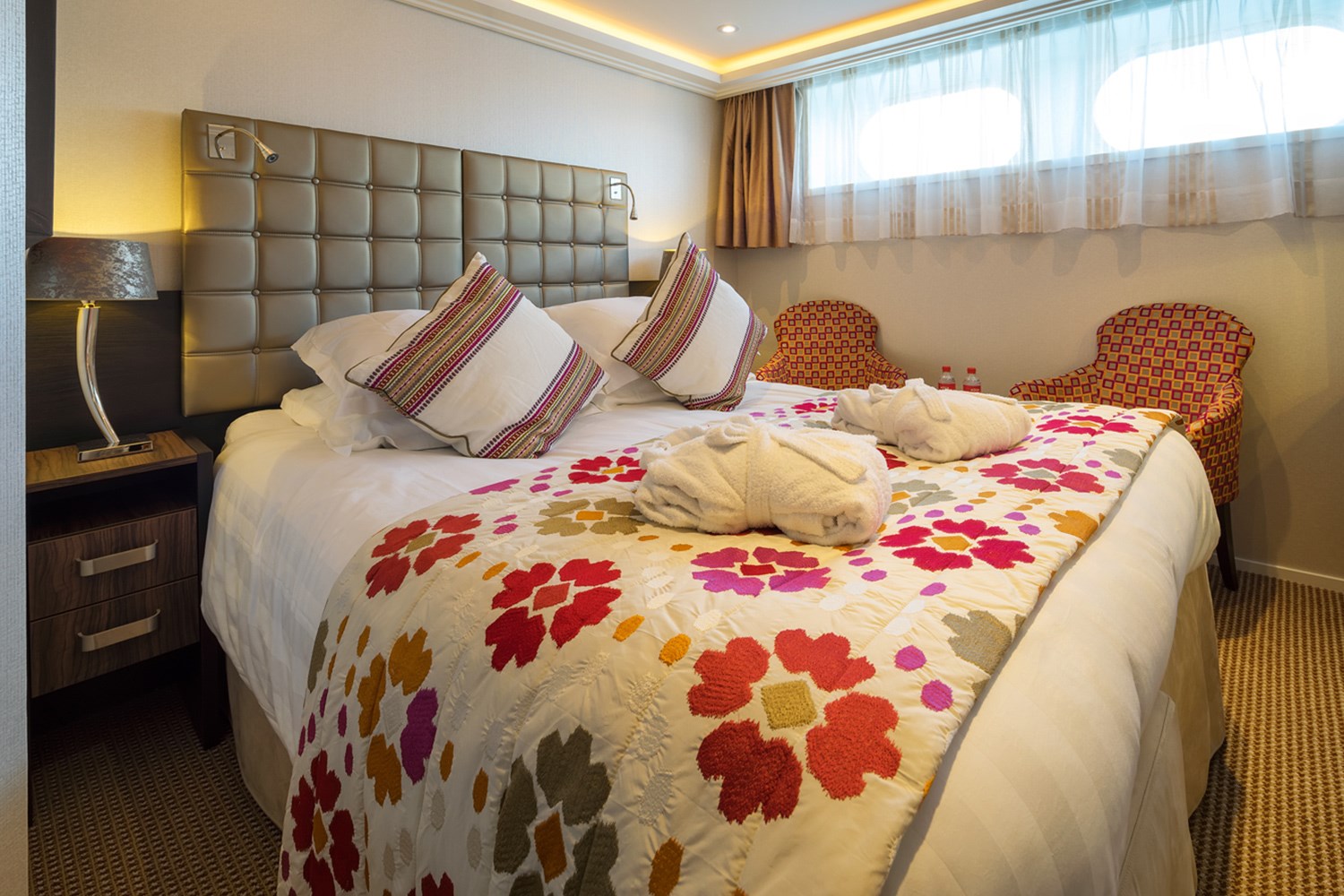
Category D Stateroom
Stateroom Features
- In-room temperature control
- Spacious bathrooms with multi-jet showerheads
- Large wardrobe, full-length mirror, hair dryer, safe and direct-dial telephone
- Flat-screen TV
- Entertainment on Demand system providing complimentary TV, movies and music library
- Complimentary bottled water replenished daily
- Complimentary internet and Wi-Fi
- Desk and chair
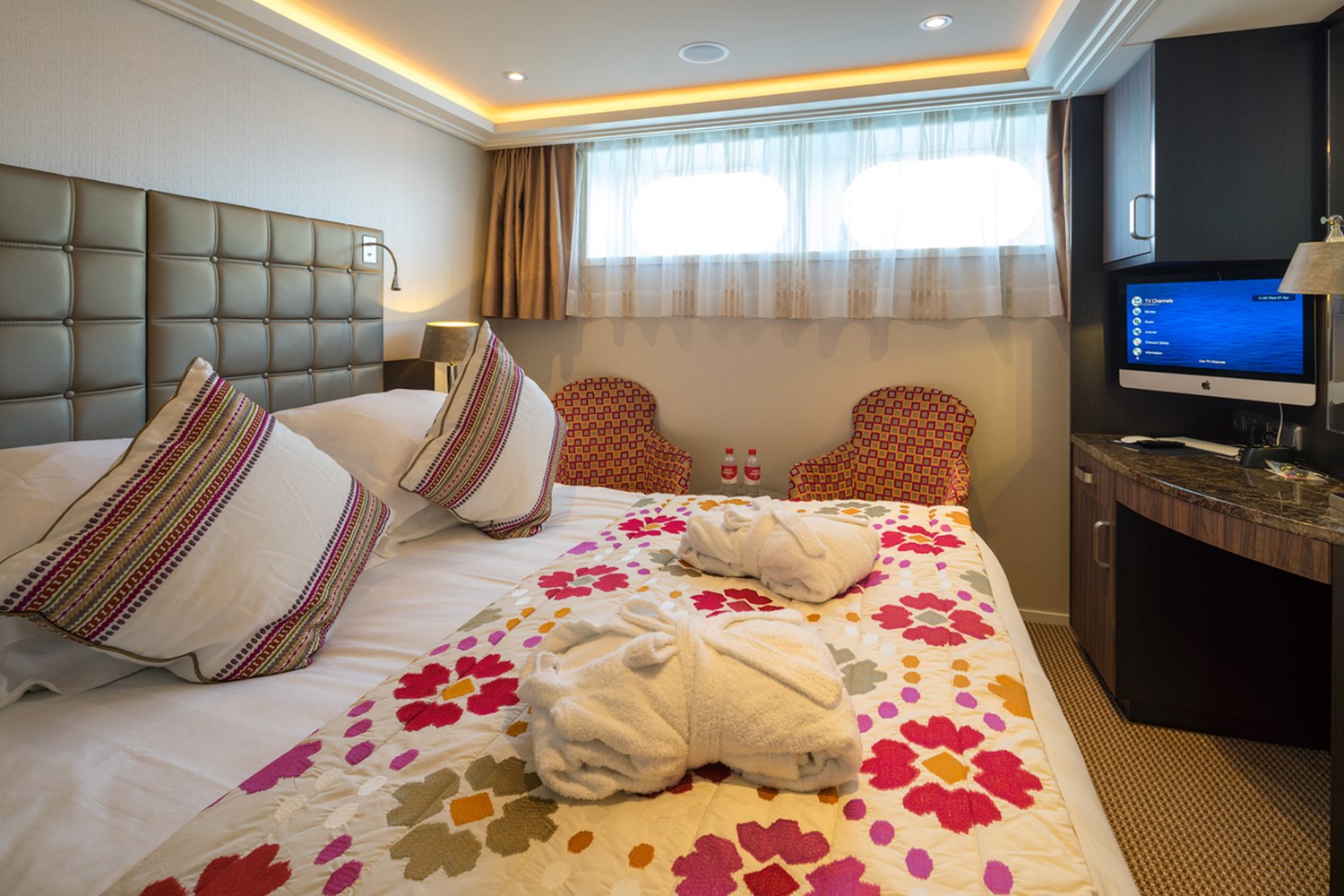
Category E Stateroom
Stateroom Features
- In-room temperature control
- Spacious bathrooms with multi-jet showerheads
- Large wardrobe, full-length mirror, hair dryer, safe and direct-dial telephone
- Flat-screen TV
- Entertainment on Demand system providing complimentary TV, movies and music library
- Complimentary bottled water replenished daily
- Complimentary internet and Wi-Fi
- Desk and chair

The Chef’s Table
Join a few of your fellow travellers at The Chef’s Table, where the kitchen — usually hidden — becomes part of the entertainment. You’ll have the opportunity to watch the chef prepare a special multi-course meal right in front of you. The menu here is unique, making this a truly distinct gastronomic experience. Indulge in delectable dishes served with unlimited fine wines, hand-selected just for this dinner. It is the only venue of its kind on the river.

Guided Bike Tours
With AmaWaterways, you have the option of exploring Europe’s amazing sights like the locals do. We were the first river cruise line to carry an entire fleet of complimentary bicycles on board, so you can experience biking alongside enchanting riverside pathways and in city centres. Whether you feel like joining one of our exclusive guided bike tours, or want to go discover on your own, there are many ways for you to explore on two wheels during your cruise. Here are a few examples:
- Bike along the beautiful Danube River between Dürnstein and Melk in Austria’s Wachau Valley
- Tour Cologne’s Old Town and Cathedral along the Rhine River
- See the medieval city of Rouen in France’s historic Normandy region, near the Seine River
- Take in wooded hills and beaches of poplars along the scenic shores of the Inn River in Passau
- Go on a guided bike ride in Vienna, where you’ll visit Klosterneuberg Abbey and enjoy cake and coffee

Guided Hiking Tours
The beauty of Europe doesn’t just lie in its architecture and landmarks – there are also breath taking things to be seen when you venture out into nature. That’s why we’ve designed special hikes that will take you a bit off the beaten path in some very beautiful destinations.
- Trek up to the Veste Oberhaus in Passau, Germany for incredible views over Old Passau
- Make your way up to Dürnstein Fortress, where it is said that Richard the Lionheart was once held captive
- Hike up the Philosopher’s Path to a panoramic view of Heidelberg and the Necker River
- Journey from the ship to the Old Town in Strasbourg, France
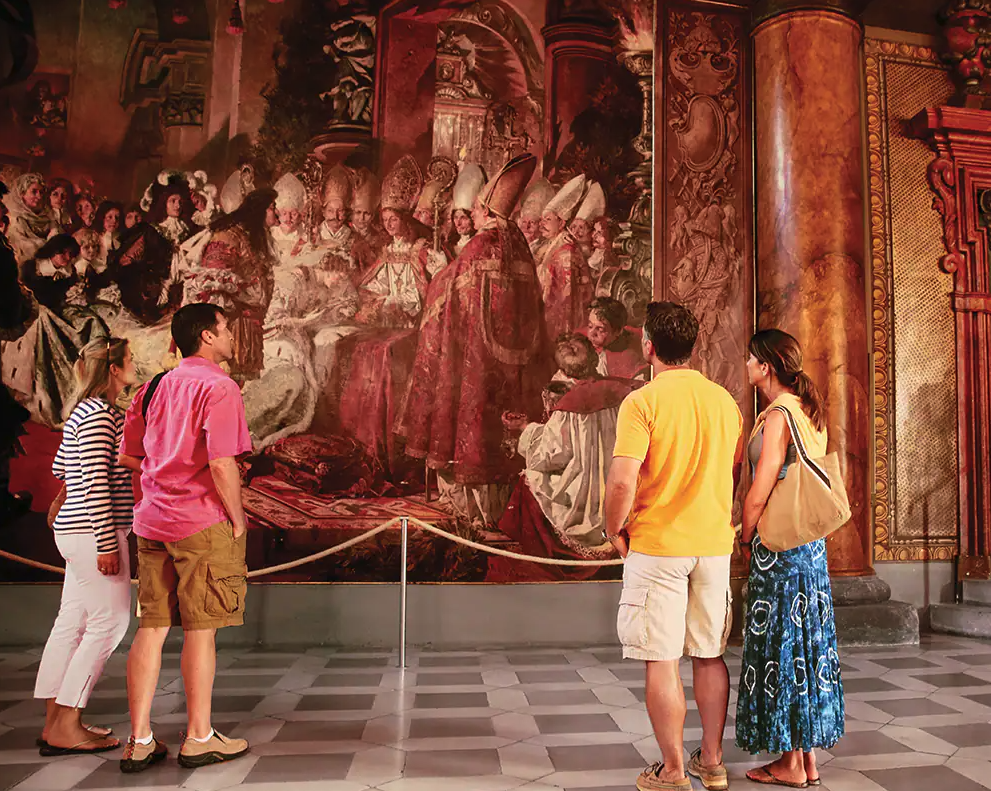
Included Tours
We realise that our guests have different tastes, so we’ve developed a menu of shore excursions in every port of call. In many destinations, you’ll be free to choose from one of several options — all of which are included in your cruise fare. There’s always a city tour designed to show you all the renowned highlights and landmarks in grand capitals and charming villages alike. Is it your first time in Vienna? Opt for an unforgettable exploration of the major sights led by a local, English-speaking guide that is well versed in history and culture. Have you already been to Nuremberg? Instead of taking the city tour, indulge in a bratwurst and beer tasting on one of our Special Interest Tours, which are specially designed to place you in the midst of local life. Are you looking for something more active? See the beautiful scenery of Austria’s Wachau Valley with a guided bike tour along the Danube. The choice is yours.
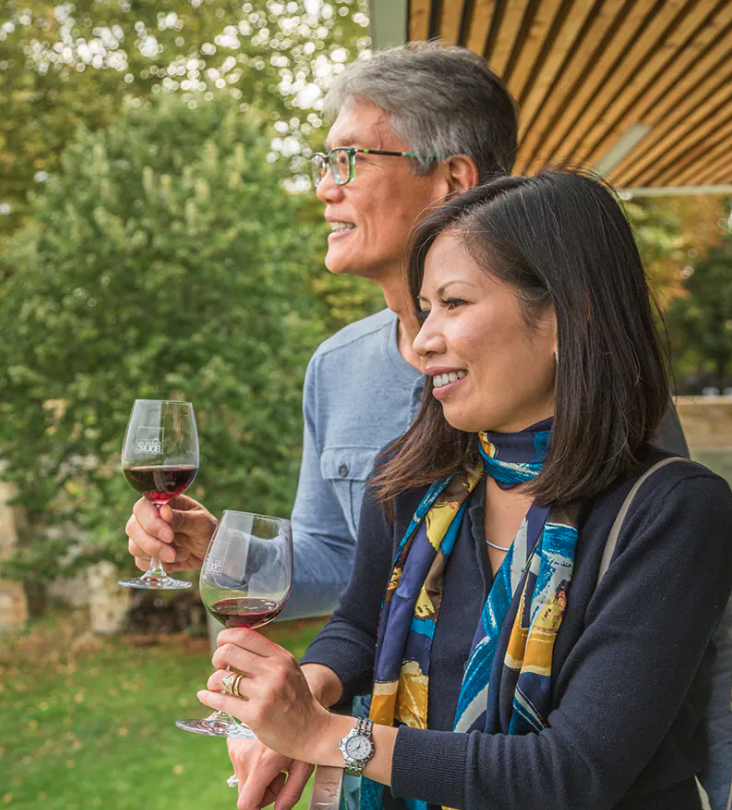
Limited Edition Tours
Every year, we seek out new opportunities for our guests to experience local culture in a unique way. These tours are specially designed to give small groups the chance to be even more immersed in a destination. Here are just a few examples:
- Indulge in authentic Belgian waffles and chocolate in Antwerp
- Try your hand at knotting a bretzel (German for “pretzel”) in Wertheim
- Go to a bratwurst and beer tasting at the oldest brewery in Nuremberg
- Discover hidden treasures on a tour of Vienna’s secret spots and sights
- Sample Bavarian specialties like pralines in Regensburg
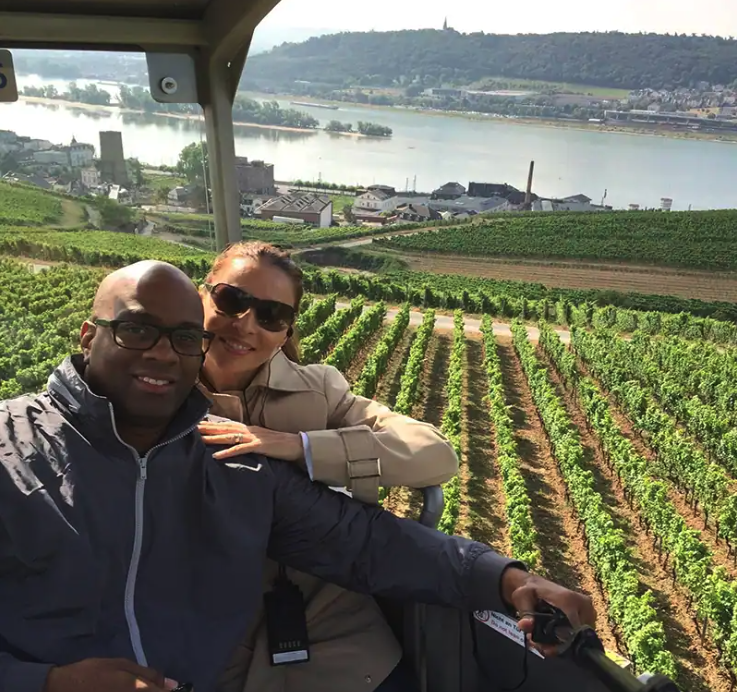
Extraordinary Experiences
On an AmaWaterways river cruise, you don’t just pass through a destination — you experience it. Each one of our itineraries is crafted with a paramount goal in mind: connecting you to the essence of life in each place you visit. We always make it a point to place our guests in small groups. This helps facilitate access to sights and landmarks, a more intimate setting, and more encounters with the locals. It’s a great way to take your time as you explore, get to know your fellow travellers better and find opportunities for up-close experiences. Every tour is led by a local, English-speaking guide who is very knowledgeable in the culture and history of the place you are visiting.
Choose your pace: In many cases, you’ll have a choice of gentle, regular and active tour paces. There are even some options for late risers.

Land Packages
Make the most of your long-awaited vacation by adding our optional land packages before or after your sailing for an all-encompassing river cruise and land journey. Indulge your wanderlust and we’ll whisk you away between your ship and hotel, plus take you on specially curated guided tours with just the right amount of leisure time to explore the art, history or culinary delights in sought-after cities around the world.
Why Add a Land Package?
There are many benefits to adding a land package before or after your sailing. One of the simplest reasons is the convenience of making all your future travel plans in one step. Our concierge services allow you to reserve your river cruise, flights, airport transfers and land packages all at once. No need to call and research multiple providers – just contact your travel advisor and we’ll take care of it all. But the value of adding a land package doesn’t stop there.
World-Class Hotels
Whether you wish to rest and recover from flights or pamper yourself before returning home, you’ll find no better respite than the trusted, 4- and 5-star hotels we have carefully selected for you. Each luxurious property is centrally located near the major sights, such as Turkey’s Istanbul at Sultanahmet, just steps from the magnificent Blue Mosque. If you should wish to extend your vacation even further, your travel advisor can conveniently arrange extra hotel nights through AmaWaterways as well.
Our land packages include transfers between your hotel and river cruise ship, portage service and daily breakfast at the hotel. In addition, fascinating guided city tours and excursions are included, so you can:
- Discover breathtaking Mont St. Michel, France, the artistic inspiration for the movie Tangled
- Join a tasting of Czech beer while learning about the beverage’s long and illustrious history
- Visit Transylvania’s infamous Bran Castle, otherwise known as Dracula’s Castle
- Board a boat for a scenic ride along Italy’s Lake Como to the stunning lakeside village of Bellagio
- Rise with the sun at Cambodia’s UNESCO-designated Angkor Archaeological Complex
What’s Included in Your Land Package
- Overnight stays at 4- and 5-star hotels conveniently located near the major sites
- Daily breakfast at the hotel
- Guided city tours
- Convenient transfers to and from the ship
- The services of a professionally trained Cruise Manager throughout your river cruise and land stay – unique in the industry
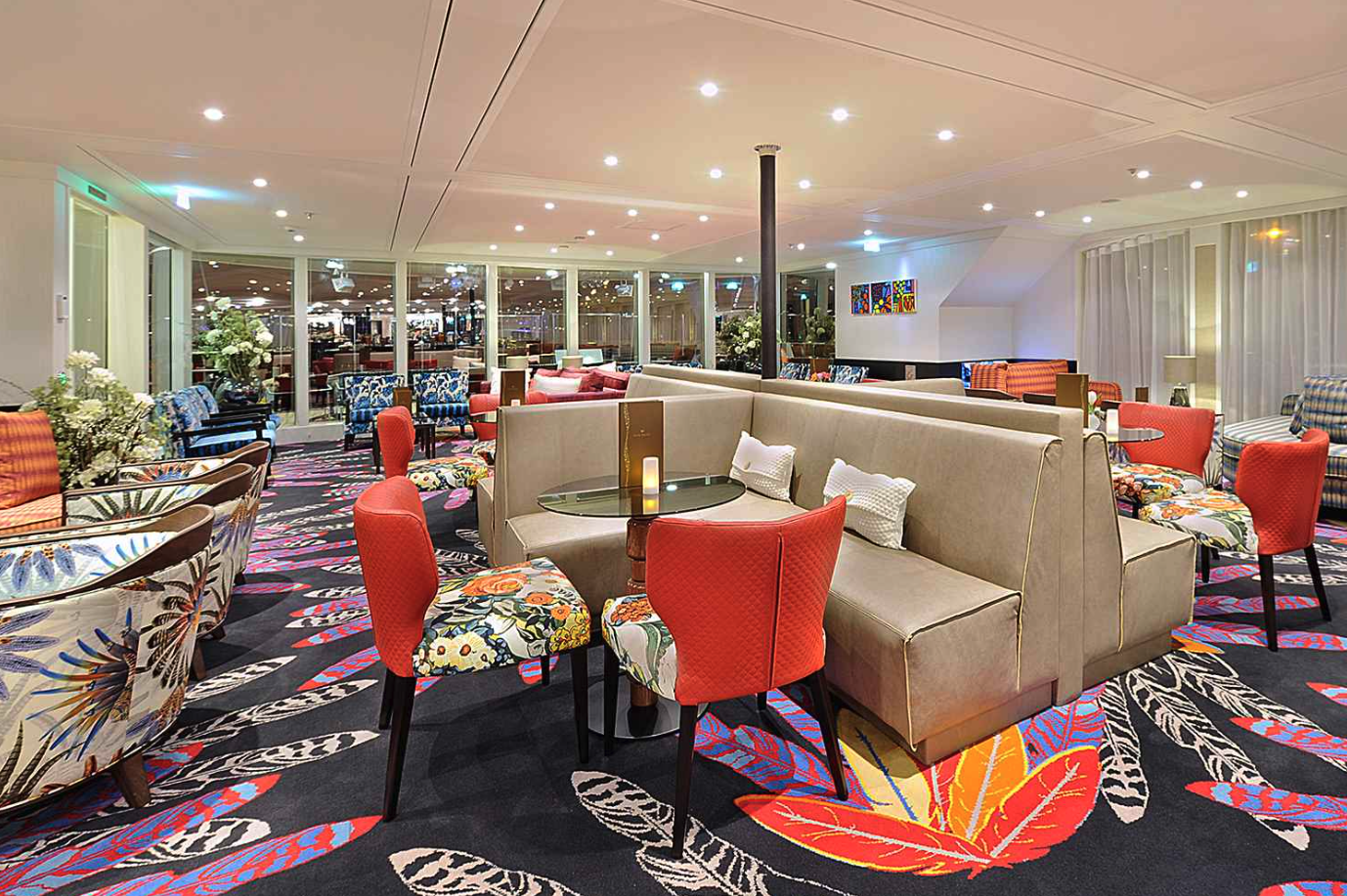
Main Lounge & Bar
Panoramic Lounge with bar, piano and dance floor

Enriching Entertainment
Whether it’s traditional Bavarian music, a local quartet or modern piano favorites, there is an eclectic schedule of entertainment on board.

Fitness Room
Are you looking for a way to stay fit on vacation? Hit the treadmill or lift some weights while cruising from one destination to the next.
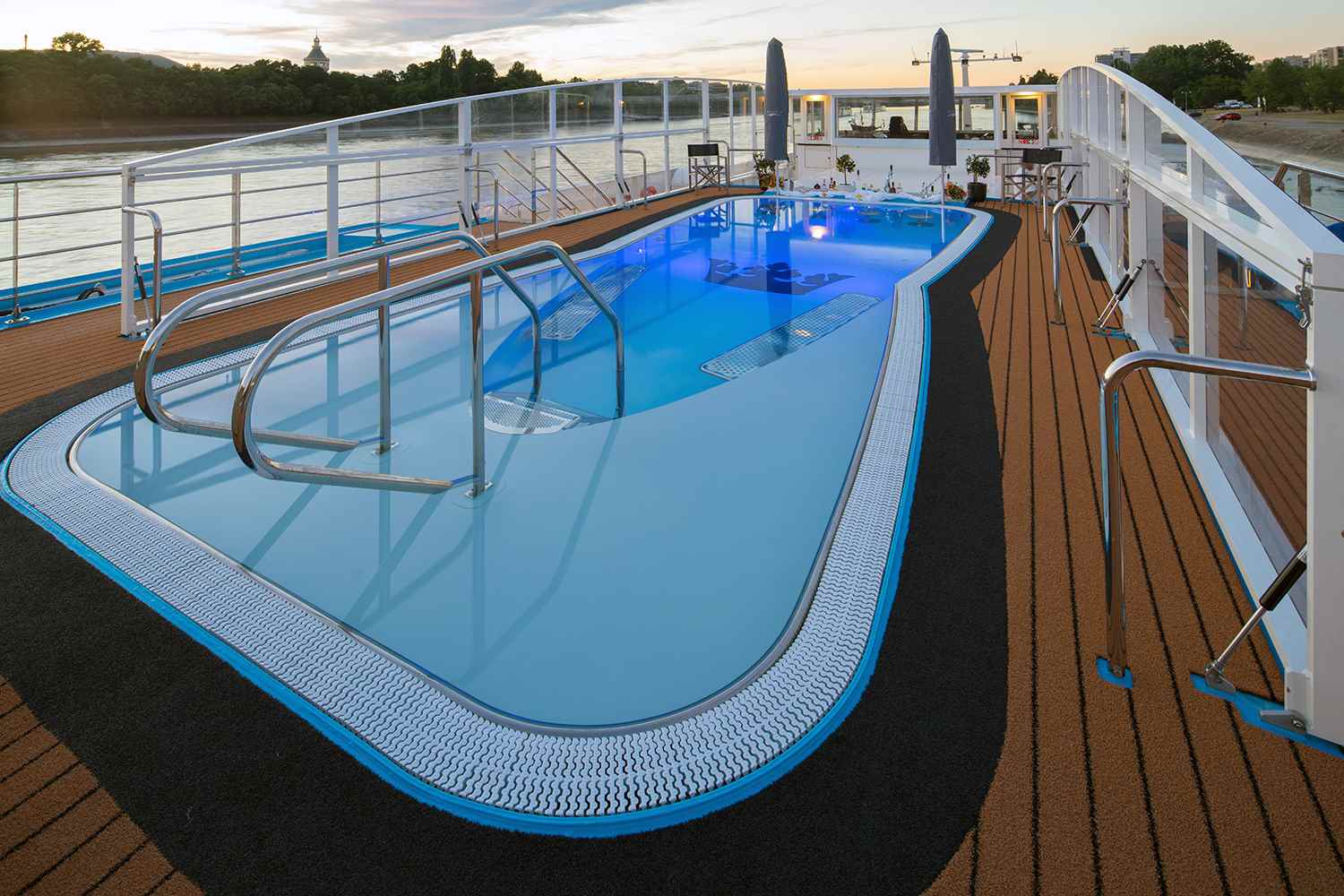
Sun Deck Pool
Soak up some rays or take a dip in our refreshing pool with a swim-up bar as we pass by centuries-old castles, charming villages and other breathtaking scenery.

Healthy Options
Lighter options are always available during meals as well as gluten free, vegetarian and low-sodium options. Discover the infused detox and gemstone water at our Hydration Station.

Massage Services and Hair Salon
After a marvelous day of immersive shore excursions, return to the ship and treat yourself to a bit of pampering with a soothing massage.
Age Restrictions
All guests under the age of 18 are to be in a stateroom with an adult and must remain supervised at all times; their safety is the responsibility of the accompanying adult(s). In the case where a triple or quad occupancy stateroom is not available or not selected, children under the age of 10 at the time of embarkation may share a stateroom with two adults only in circumstances where the child is able to share the bed with the adults – no additional bed will be provided. Please be aware that balcony staterooms of any kind may be unsafe for minors if left unsupervised. There is a minimum age limit of 4 years old, unless otherwise agreed upon by AmaWaterways.
On our Africa Safaris & Wildlife Cruise program, due to safety precautions, there is a minimum age limit of 12 years old, unless otherwise agreed upon by AmaWaterways.
AmaWaterways does not provide child-specific programs or child-minding facilities. Please reach out to us if you have any further questions regarding our child policy.
Disabled Facilities
Reasonable efforts are made to accommodate the special needs of disabled cruise participants, but no responsibility will be undertaken for any denial of services by carriers, hotels, restaurants, or other independent suppliers. Tour buses are not equipped with wheelchair ramps and cabin doors are not wide enough to allow access by standard wheelchairs.
Wheelchairs and walkers cannot be carried on tour buses, due to space limitations. Wheelchair passengers should be aware of these limitations. For safety reasons, passengers in wheelchairs cannot be carried on ramps in ports where the ship is at anchor. We regret that we cannot provide individual assistance to a tour member for walking, getting on/off tour busses and other transportation vehicles, or other personal needs. A qualified travel companion must accompany travellers who need assistance.
Smoking Policy
Smoking is not permitted anywhere inside any of the ships. Smoking is only permitted on the Sun Deck. For the safety and comfort of all passengers on board, your cooperation in observing the no-smoking policy is greatly appreciated.
Dietary Requirements
Please advise your Travel Agent or call us directly to advise if you have any dietary restrictions or allergies prior to embarkation. In most cases, we will do our best to accommodate special dietary requests and food allergies, but with one exception: Kosher. This diet has specific rules regarding food and its preparation and the shipboard environment does have limitations that prevent us from being able to adequately cater to this dietary need. Please note, though we can provide options to accommodate food allergies and sensitivities, we cannot guarantee there will not be any cross-contamination.
Dress Code
Europe: Comfortable, layered clothing adaptable to changing weather conditions is always advisable for daytime excursions. For the evening, “Casually elegant” attire is recommended and you may want to pack something a little dressier for the Captain’s night/Farewell Dinner – similar to how one would dress to dine at a 5-star restaurant. Comfortable shoes are recommended for excursions and workout clothing if you plan to take part in any wellness activities, active tours or use the onboard gym. Depending on the time of year, clothing that can be layered is highly recommended.
Vietnam & Cambodia: It is always advisable to travel light in Southeast Asia. For the hot and humid weather, lightweight easy-care clothing that includes some long-sleeved items for protection from mosquitoes and sun, raingear, and sturdy and comfortable walking shoes that you won’t mind getting wet or muddy. We also recommend you pack a few casually elegant items to wear at the Welcome and Farewell dinners.
Africa Cruise & Land Safari: When traveling through Africa, it is always advisable to travel light as some itineraries baggage size and weight are strictly limited. On Safari: casual, easy-care clothing that includes some long-sleeved items for protection from mosquitoes and sun. Attire during Winter (April – September): it is wise to bring some warm clothes for chilly early morning and late night temperatures. Dressing in layers is also recommended, as temperatures rise quickly during the day.
Egypt: Packing light for your Nile River cruise will be no problem as a majority of what you pack into your suitcase will be lightweight clothing items. Breathable clothes will be your answer to most of your outfits. We suggest cotton or linen tee shirts as well as short and long sleeves.
As Egypt, Jordan and UAE are primarily Muslim countries, you should plan to dress modestly to respect the local traditions of the mosques and temples you will be visiting. A lightweight pashmina scarf, veil or shawl is ideal for additional sun protection and as women will need to cover their shoulders and arms. Men can opt for collared shirts and lightweight pants.
Medical Facilities
Europe: There are no medical facilities on board. However medical services can easily be called from shore if required.
Vietnam & Cambodia: We do not employ doctors or nurses on board the ships. In the event medical assistance is needed, appropriate medical facilities will be contacted. Note that response time can vary.
Africa: We do not employ doctors or nurses on board the Zambezi Queen. In the event medical assistance is needed, appropriate medical facilities will be contacted. Note that response time can vary.
Internet and Wifi Access
Europe: High-speed Internet service is available free of charge as part of the in-stateroom “Entertainment-On-Demand.” Additionally, AmaWaterways offers complimentary Wi-Fi throughout the ship.
Vietnam and Cambodia: Free Internet and Wi-Fi in the lounge with computer stations.
Africa: Free Wi Fi is available but may be limited and sporadic during certain times of the day due to the ships isolated location.
Sustainability
Environmentally-Friendly Ship Design
Our river cruise fleet has been thoughtfully designed with eco-friendly elements. These include energy-saving LED lights, special insulated windows that reduce energy needs for heating and cooling, power locks to plug into a port’s power supply instead of running generators, solar heating systems, water treatment plants that provide microfiltration and recycling of all water used on board. AmaMagna also has an innovative 10-engine configuration designed to reduce fuel consumption and solar panels have been installed on all stateroom balconies. In addition, the Zambezi Queen uses a water jet propulsion system that protects the Chobe riverbed, water-saving taps and showers, biodegradable detergents and soaps, and a five-stage water purification plant.
A Greener Onboard Experience
To reduce overall plastic consumption, we use paper straws (upon request), refillable glass water bottles in all staterooms, and hand out recyclable tetra-pak water containers for excursions across the fleet (where available). We have lessened unnecessary food waste from large-scale buffets by serving a la carte lunches on board our European fleet. For our personal audio devices used on excursions, we are proud to partner with Quietvox, which utilizes biodegradable rice paper bags and rechargeable batteries. In addition, our luggage tags and handy travel wallets are both made from recycled plastic bottle material and are now delivered to guest staterooms on board our ships in Europe, reducing our carbon footprint. The usage of our innovative myAmaCruise app and electronic travel documents has also significantly reduced paper consumption both pre-cruise and on board.

Sun Deck
- Lower Sun Deck
- Navigation Bridge
- Bicycles
- Heated Pool
- Sun Deck
- Walking Track

Violin Deck
- Al Fresco Terrace
- Observation Lounge
- Main Lounge & Bar
- Gift Shop
- Reception
- The Chef’s Table Restaurant
- Suites
- Cat AA Staterooms
- Cat BA Staterooms
- Cat CA Staterooms
- Cat CB Staterooms
- Elevator

Cello Deck
- Main Restaurant
- Cat AB Staterooms
- Cat BB Staterooms
- Cat CA Staterooms
- Elevator

Piano Deck
- Massage Room & Hair Salon
- Fitness Room
- Crew Cabins
- Cat D Staterooms
- Cat E Staterooms
- Elevator


